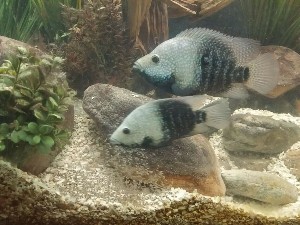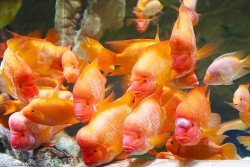Texas Cichlids: A Bold & Beautiful Fish from the Lone Star State
 The only cichlid found naturally in the United States is the territorial Texas cichlid. It is highly recommended that only experienced aquarists with a tolerance for challenging fish keep this Central American relative.
The only cichlid found naturally in the United States is the territorial Texas cichlid. It is highly recommended that only experienced aquarists with a tolerance for challenging fish keep this Central American relative.Although isolation is preferable, the Texas cichlid can be housed in an aquarium with other hardy fish if the tank's capacity is at least 125 gallons. A pair of Texas cichlids can also live in such an aquarium, though you may need to split it in two if you end up with incompatible cichlids.
The Texas cichlid is a popular game fish native to the lower Rio Grande Drainage in Texas and northeastern Mexico. The Rio Grande perch is a species of fish that lives in the Rio Grande and can be found in tributaries and pools as well as the main river. Down river, locals call it mojarra del norte, or northern mojave.

An Inspiring Charmer
Herichthys cyanoguttatus is one of the most well-liked aquarium fish due in part to its visually pleasing design. The juvenile Texas cichlid has a pearly gray body and fins with white spots, and two black spots (one in the middle of the body and one at the base of the caudal fin) that are distinctive. The body of a fully grown specimen turns a golden color with pearly overtones, and white and turquoise spots decorate the fins and body.
Three black bars run along the body of the adult fish, and the back half of its body (including the base of its caudal fin) is covered in numerous small black dots. If you succeed in putting your aquarium fish into breeding mode, its underbelly will turn black and its three black bars will deepen in color.
Tank size
Due to their potential growth to a length of 12 inches, adult Texas cichlids should not be kept in aquariums of less than 75 gallons. You should use sand to cover the bottom of the aquarium and include lots of rocks and roots to make it look like the fish are living in their natural environment. Fish will feel more at home with live plants, but avoid using delicate varieties around Texas cichlids because they like to burrow near plant roots. As well as floating plants, rooted plants can also be used to reduce the amount of light in the tank and provide cover for the fish.
The ideal aquarium temperature for the subtropical Herichthys cyanoguttatus is between 70 and 75 degrees Fahrenheit, but this fish can thrive in a wide range of temperatures. The pH of the water should be between 6.5 and 8.0, with 6.5 being neutral and 8.0 being slightly acidic. Water hardness should be between 8 and 25 dH for optimal use.
Characteristics of Tankmates and Their Personality
It has been established that the Texas cichlid is a combative species, so it is recommended that it be kept only with similarly aggressive fish. For example, if your aquarium is sufficiently large, it can be kept with similarly sized aggressive Central and South American cichlids. It's also worth noting that while some specimens are extremely hostile to other fish, others can be quite docile. The distinct character of each fish is subject to development over time. Certain specimens, especially as they age and become nearly impossible to keep with any other fish, are better off in their own aquarium.
The Texas cichlid is not a picky eater, accepting flakes and pellets with equal enthusiasm. However, in my experience, a Texas cichlid will remain much healthier and happier in the aquarium when provided a varied diet containing live (or at least fresh or frozen) foods, so I do not recommend keeping H. cyanoguttatus on a diet consisting solely of dry food. I like to mix in a lot of thawed live meaty foods like worms and shrimp with a base of high-quality flakes and pellets. Even a fierce predator like the Texas cichlid eats a lot of green food in the wild, so I make sure to include plenty of vegetables and algae-based foods in the diet as well.
Creating One's Own
If you can find a mate for your Texas cichlid, raising them yourself is easy. However, even mated Texas cichlids are known to fight frequently. To identify a female, just look for the black spot on her dorsal a feature absent in males. The male fish is larger and more vividly colored than the female. Some older males develop a cranial bump, while others never do, regardless of their age, and female specimens have also been reported to have bumps.
Breeding
Provide your fish with a flat surface, like a flat stone, to use as a breeding site if you want to encourage reproduction. Females begin cleaning the breeding site when they are ready to reproduce, which is usually between 2 and 3 inches in length. During the actual spawning process, she can lay over a thousand eggs, each measuring about 2 mm in diameter.
Parenting
Both sexes of the Texas cichlid are doting parents and help tend the eggs and young. While the female cichlid tends to the eggs, the male cichlid protects the territory. It might seem like a good idea to give them their own breeding aquarium, given that both sexes become extremely aggressive while tending to eggs, but I must advise against it. Because there are no other fish in the tank for him to attack, an aggressive male fish may harm or kill his female companion. As a result, it's best to house the couple alongside other fish in a spacious, tastefully decorated aquarium with plenty of places for them to hide. Use a divider to separate the male from the female and the eggs.
Fry
In order to breed healthy Texas cichlids, you must maintain extremely high oxygen levels and minimal organic waste. Within three to five days, the female lays her eggs, and the female will help her young emerge. The larvae will be moved to a hole dug in the sand, where they will remain for five to eight days.
Fry in free-swimming conditions are typically large enough to eat newly hatched brine shrimp and powdered flakes, and they will also eat organic matter in the aquarium. It's normal for Texas cichlid couples to go through a few trial runs before they get it right, so don't give up if the parents eat the first few batches.
Shades of blue, green, and red: hybrids?
Blue Texas cichlids, green Texas cichlids, and red Texas cichlids are all common names for the same family of fish in the aquarium trade. The use of these common names for different color forms of Herichthys cyanoguttatus, hybrids, and entirely different species can lead to considerable confusion. Many pet stores sell H. carpintis, H. cyanoguttatus, H. labridens, and other North and Central American blue cichlids under the common name blue Texas cichlid. Species like the Herichthys sp. "Rio Cazones," Herichthys sp. "turquoise," and Herichthys sp. "Poza Rica" are commonly referred to as "blue Texas cichlids" despite not having official scientific names.
The meaning of the word green The term "Texas cichlid" is most often applied to H. carpintis, a relative of H. cyanoguttatus. However, the term is also applicable to other species and variants of cichlids. H. carpintis is only known from specimens taken from Mexican waters; its presence in Texas is doubtful. The spots on an H. cyanoguttatus are smaller than those on an H. carpintis, so that's one way to tell the two species apart. As was previously mentioned, H. carpintis can also be found for sale under the name blue Texas cichlid, further confounding the issue for would-be cichlid keepers. The pearlscale cichlid, or lowland cichlid, is another name for this fish.
Aquarium hybrids of Texas cichlids and other cichlids are commonly referred to as "red Texas cichlids." Therefore, the red Texas cichlid's ancestry is both mysterious and uncertain. The number of fry that mature into vivaciously red show cichlids is extremely low, even in a good batch, and the quality of fry sold under the name red Texas cichlid or red flowerhorn varies greatly. An appreciable fraction of each batch will never turn red, and black spotting is common even among the red ones. A "red" Texas cichlid may actually have more black in their coloring than red.
Caretaking
It's a relief to know that the majority of the species, hybrids, and variants sold under the name Texas cichlid have similar husbandry requirements and will appreciate roughly the same type of environment, diet, and care. Identical mating habits have been observed between the two species. To learn the specifics of how to care for and breed your specimens, however, you may need to engage in some trial and error. Keep in mind that keeping fish of unknown origins or mislabeled species together raises the possibility of hybridization in the aquarium.
Most fishes sold under the Texas cichlid flag share some common characteristics, but this does not mean they are all the same or only slightly different. For instance, while H. carpintis will typically not exceed 8 inches in length, H. cyanoguttatus can grow to a whopping 12 inches in length; this obviously has major repercussions for the minimum and maximum aquarium sizes that are recommended. The temperamental differences between people is another factor to consider. The red Texas cichlid hybrid, for example, is known to be even more violent than H. cyanoguttatus, making it more challenging to combine with other fish. However, H. carpintis is commonly housed in community aquariums with fish that are only mildly aggressive toward one another.
FAQ's
What is the Texas cichlid?
The Texas cichlid (Herichthys cyanoguttatus) is a large, robust cichlid species native to rivers and lakes in Texas and northeastern Mexico. It is the official state fish of Texas. This fish is prized for its bright coloration and bold personality.
Where are Texas cichlids found?
In the wild, Texas cichlids are endemic to drainages of the Rio Grande River basin in Texas and Mexico. They prefer warm, slow-moving waters with vegetation and fine substrates.
How big do Texas cichlids grow?
Texas cichlids can reach up to 12 inches (30 cm) in length in captivity when fully grown. In the wild, they may achieve lengths of up to 18 inches (46 cm).
What do Texas cichlids eat?
Texas cichlids are omnivorous, feeding on insects, smaller fish, plant matter, and detritus in their natural habitat. In an aquarium they accept a variety of foods like pellets, flakes, live and frozen items.
Are Texas cichlids aggressive?
Yes, Texas cichlids are highly aggressive and territorial, especially when breeding. Tankmates should be selected carefully and adequate space provided.
What size tank do Texas cichlids need?
At minimum a 55 gallon aquarium, but a 75 gallon or larger tank is recommended to provide sufficient space for their aggressive tendencies.



